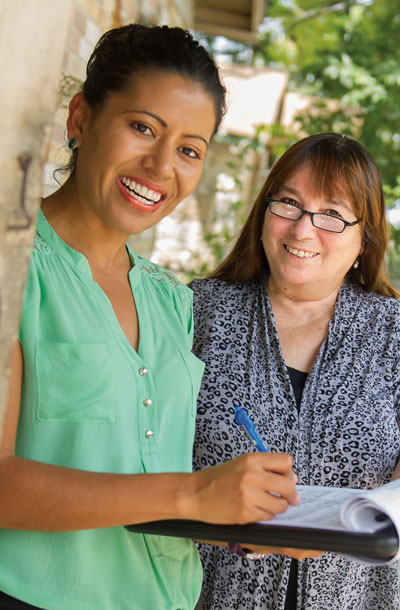It was like a small, round bean; solid and smooth. Jovita De Leon, 62, described the lump she felt in her left breast. Over time as it grew, she felt something else deep in the pit of her stomach – fear. It was enough to scare her into seeking a doctor.
Visits to the doctor were not common for De Leon who doesn’t have health insurance and whose income is limited by the number of sewing jobs she can get. She works as a seamstress out of her home on San Antonio’s West Side. Without a vehicle, transportation to a doctor’s office is problematic. But this time she needed to get there. “What if the lump was cancer?” she thought to herself. As a mother, grandmother and caretaker of her 94-year-old ill father, De Leon couldn’t afford to be sick. Her family needed her.
It took two weeks, but with help from her grown children and money from her job, De Leon was able to gather the $75 needed for a visit to the doctor. After her clinical exam, De Leon still didn’t have all the answers. She knew it was serious when the doctor told her it was urgent she get a mammogram.
“He even gave me my money back,” De Leon said. The physician sent her home with a list of phone numbers for clinics that offered low-cost scans. Even with $75 and clinic phone numbers, De Leon, who only speaks Spanish, had problems communicating her needs over the phone and trouble saving the $300 needed for the test.
Months passed and De Leon began to feel sick and listless. She had fever and intense pain. After several failed attempts to secure a mammogram, her morale was shot.
It was the fall of 2011 and Thanksgiving was quickly approaching. On one of De Leon’s many sleepless nights, she saw an advertisement on television for an upcoming free health fair to be held in front of San Fernando Cathedral. It seemed to be De Leon’s last hope. So her daughter, Gabriela Benavides, drove her downtown the next day. They arrived at 7 a.m. But to their dismay, police officers were closing down the streets. A fire that ignited in a building nearby caused the cancellation of the fair. Discouraged, desperate and in pain, De Leon prayed for help and hope.
Study shows Latinas left behind
A national research study conducted by the Institute for Health Promotion Research (IHPR) in the Long School of Medicine at the UT Health Science Center at San Antonio and the Redes En Acción: National Latino Cancer Research Network, which is funded by the National Cancer Institute, showed that the average time for Latinas’ to receive a definitive diagnosis of breast cancer was 60 days, compared with just 27 days for non-Hispanic white women. The study was published this year in the journal SpringerPlus.

Institute of Medicine member Amelie G. Ramirez, Dr.P.H., who leads the Institute for Health Promotion Research in the Long School of Medicine, has spent more than 30 years directing programs focused on reducing chronic disease and cancer health disparities affecting Latinos in South Texas. She is the Dielmann Chair in Health Disparities Research and Community Outreach and the Max and Minnie Tomerlin Voelcker Endowed Chair in Cancer Healthcare Disparities and Outreach at the CTRC.
“This lag time puts Latinas at greater risk of being diagnosed with larger tumors and more advanced-stage breast cancer. The delay can affect prognosis,” said Amelie G. Ramirez, Dr.P.H., who is an author on the study and director of the IHPR and Redes En Acción. “With cancer being the leading cause of Latino death, this study also signals a greater need for ethnically and culturally appropriate interventions to facilitate Latinas’ successful entry into, and progression through the cancer care system.”
For De Leon, the time delay was much longer. It was an entire year after she first discovered the lump in her breast that she learned about a University Health System financial assistance program for Bexar County residents, signed up and received the referral for the diagnostic mammogram she needed.
By then, she could see the lump protruding through her skin. The imaging revealed several more tumors that had developed. A biopsy was the next step and she was put in touch with doctors at the University Health System mammography Center at the Cancer Therapy & Research Centers (CTRC) at the UT Health Science Center San Antonio.
“As soon as I came to the CTRC, everything moved fast,” De Leon said. Two days later, she underwent a seven-hour biopsy and finally received the news she’d waited so long for. De Leon had two types of cancer – invasive ductal carcinoma and ductal carcinoma in situ with focal micro-invasion. Invasive ductal carcinoma is the most commonly diagnosed breast cancer in women. It grows through the milk duct walls into the surrounding breast tissue and can spread to other parts of the body. Ductal carcinoma in situ is more contained, but is the precursor for invasive cancer.
Doctors told De Leon she’d need surgery immediately.
Two weeks before Christmas, on Dec. 9, 2011, De Leon underwent a complete mastectomy (surgical removal) of her left breast at University Hospital. Alfredo Santillan, M.D., performed the procedure. Dr. Santillan is a UT Health San Antonio surgical oncologist and assistant professor in the Long School of Medicine.
“My luck changed that day,” De Leon said. “Dr. Santillan was very warm. He spoke to me in Spanish. He understood me. He was very kind and he saved me. I will always be grateful to him.”
In addition to the care she received at the CTRC, De Leon was introduced to Guadalupe Cornejo – a woman she calls “mi ángel de la guardia,” (my guardian angel). Cornejo is a patient navigator who works at the UT Health Science Center’s IHPR.

Patient Navigator Guadalupe Cornejo (left) pays a visit to patient Jovita De Leon at her home on the city’s West Side. Photo by Lester Rosebrock, Creative Media Services
Guiding patients to good health
Studies at the IHPR and its Redes En Acción network, led by Dr. Ramirez and her team, found that extra support for patients from trained patient navigators, like Cornejo, can lead to faster diagnosis and shorter time delays between an abnormal mammogram and definitive diagnosis – whether positive or negative for breast cancer – than those who did not receive navigation. Services provided by navigators include culturally sensitive support and help overcoming barriers related to transportation, child care, insurance, language and more.
“We’re now testing if patient navigation also can speed the lag time Latinas have from receiving that diagnosis to starting their treatment,” Dr. Ramirez said. Her team includes Cornejo, Armida Flores, Arely Perez and National Study Coordinator Sandra San Miguel.
Cornejo follows up with De Leon on her doctor appointments, prescription renewals and connects her with accessible health care resources. Last year, Cornejo introduced De Leon to a community-based wellness center for women surviving cancer where she now receives counseling and participates in a support group for Spanish-speaking cancer survivors. There, De Leon was also fitted for a prosthesis and special bra, which she received at no cost.
“Jovita could have died if she hadn’t gotten help,” Cornejo said. “She’s a strong woman. She just got lost in the system. I’m helping her find her way back.”
De Leon said her future is brighter. “I feel loved and I have my self-esteem again. I learned that there are really good people out there who you can trust, who will listen to you and take good care of you. This is a very good program. There should be more like it.”
For more information
Learn more about the Institute for Health Promotion Research and the patient navigator program at ihpr.uthscsa.edu. Visit the Cancer Therapy & Research Center at cancer.uthscsa.edu or call Sheri Ortiz at 210-450-5512.
Cliff Despres of the Institute for Health Promotion Research at the UT Health Science Center, contributed to this story.
